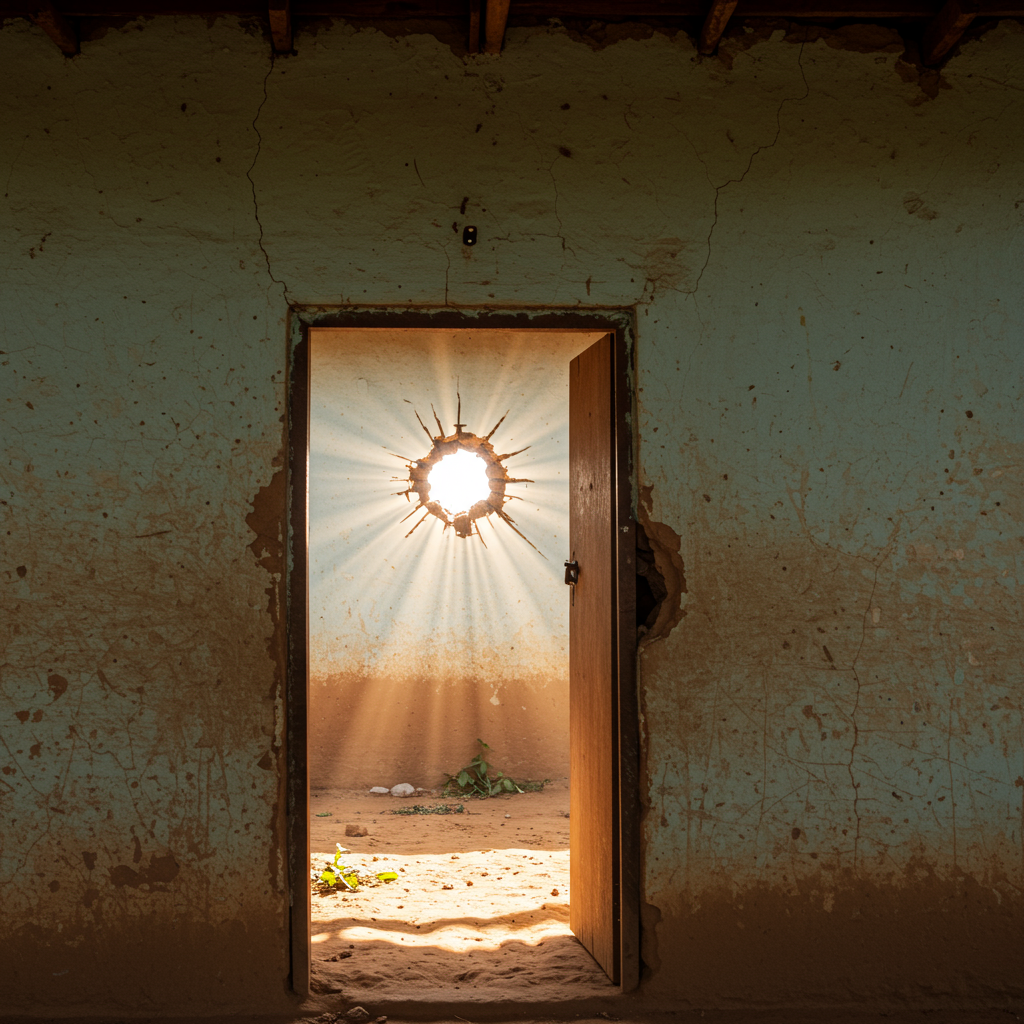Anti-government protests swept across Kenya on July 7th, a day historically known as Saba Saba Day. The day brought widespread demonstrations over the rising cost of living, new taxes, national debt, and concerns about police conduct. Tragically, the violence reached into a family’s home, claiming the life of a young girl.
Twelve-year-old Bridgit Njoki sat watching television in her family’s modest house in Ndumberi village, Kiambu County. Her home was nearly two kilometers from a main road where intense clashes occurred. Her family believed they were safe, far from the epicenter of the unrest.
A Bullet Pierces the Calm
Around 6:20 pm, a single bullet pierced the corrugated iron roof of the home. It tore through the ceiling before striking Bridgit in the head. Her mother, Lucy Ngugi, heard a loud bang. She initially saw blood on Bridgit’s hand, thinking it a minor cut. Then, the girl collapsed.
“Mum, my child has been shot!” Lucy screamed, rushing with her daughter to her own mother’s nearby home. Bridgit was quickly transported to a local health facility. Despite efforts to resuscitate her, she was pronounced dead within hours.
“She was my everything,” Ms. Ngugi later recounted, sobbing. “She was all I had.” The grief was profound, a stark contrast to the violence outside their walls. “Inside the house? Oh Lord, this is painful,” she lamented.
Broader Context of the Protests and Casualties
Bridgit Njoki’s death highlights the severe human cost of the escalating political tensions in Kenya. She is one of the youngest victims in a period marked by significant casualties. According to the Kenya National Commission on Human Rights (KNCHR), nearly 70 people have died and hundreds have been wounded in major protests since mid-June.
These demonstrations, heavily involving young Kenyans, voice deep discontent. Issues driving the protests include:
Rising Cost of Living: Economic hardship and difficulty affording basic necessities.
Tax Hikes: New or increased taxes impacting citizens’ finances.
Runaway Public Debt: Concerns over the national debt burden.
Police Brutality: Allegations of excessive force used by law enforcement.
Police Response and Contested Narratives
On July 7th, authorities barricaded main roads anticipating demonstrations. Video evidence shows police deploying tear gas. In some residential areas where protesters had regrouped, live rounds were reportedly fired.
Bridgit’s grandmother, Margaret Njeri, described the horrific moment. “The bullet came over the roof,” she said. “It penetrated into the ceiling, right where Njoki was seated.”
Despite the clear evidence of a gunshot wound, police reportedly dismissed the family’s claims. They insisted a bullet could not have traveled from the main road to their house. However, Bridgit’s post-mortem examination told a different story. Doctors retrieved a bullet from her body. The report stated her head injury was “consistent with a gunshot.” This official finding contradicted the police’s initial dismissal.
A Life Full of Promise Lost
Bridgit Njoki was a Grade 7 student at Benson Njau School. As the firstborn child, she was a vital part of her family. She was a caretaker, a helper, and the pride of the household. Her grandmother fondly recalled her academic excellence. “She was always number one in her class,” Margaret Njeri stated.
Beyond academics, Bridgit was known for her character. “So obedient, so specific, so neat,” her grandmother said. “Even in the way she spoke. She was just a very good girl.” She was active in her community, serving in church. She helped her younger siblings and cooked for her grandmother. “She was everything,” Ms. Njeri emphasized.
Her mother described her as “a beautiful girl, a charming girl, who had so many dreams.” Her father was reportedly crushed by grief, unable to speak. Her siblings remained silent, the weight of loss heavy in the home. Her empty chair serves as a stark reminder of the life violently taken.
Echoes of Violence: Other Victims Emerge
Bridgit’s death is not an isolated tragedy. Reports from various parts of Kenya detail other lives lost during the same period of unrest, many allegedly at the hands of police. Families across different counties recount similar stories of loved ones caught in the crossfire or reportedly targeted away from protest hot zones.
Examples of other reported fatalities during this period include:
Elvis Musavi (25, Nairobi): Allegedly shot in the back near his home while checking on the situation before going to work. He left behind a six-month-old child.
Paul Makori (35, Nairobi area): Reportedly shot dead just outside his house after police ordered people away. His wife stated he was not protesting and was the sole provider for their three children.
Dennis Mwangi (23, Kiambu town): Shot dead outside his home. His mother said he was shot from the back while stepping outside to observe, indicating he may have been trying to flee.
Laban Kagunda (25, Ndumberi village): Shot in the head outside his home in the same village as Bridgit. His mother stressed he was not a criminal.
Jeremiah Oscar (24, Ngong): Reportedly shot in the neck by a police officer while taking an alternative route home, avoiding main clash areas.
Paul Mburu Issa (26, Ngong): Allegedly shot dead by police while not protesting, leaving behind a pregnant wife.
Many families report their loved ones had bullet wounds on their backs, suggesting they were shot while running. Advocates claim the violence stems from excessive police force, sometimes linking it to official pronouncements.
Calls for Justice and Accountability
The level of violence and the deaths of civilians, including children, have drawn international condemnation. The United Nations expressed deep concern. They criticized Kenyan police for using “lethal ammunition” against protesters.
The situation mirrors previous crackdowns. The KNCHR reported over 50 deaths during police action against protests the previous year.
President Ruto has taken a firm stance. Following the July 7th protests, he issued a directive concerning individuals burning property. He reportedly stated they should be shot in the leg, hospitalized, and then taken to court. He specified, “Don’t kill them, but ensure their legs are broken.” President Ruto has accused political rivals of inciting violence. His opponents deny these allegations.
Back in Ndumberi, Bridgit’s family is focused on mourning. They are also calling for an end to the brutality. Families of victims elsewhere face not only grief but also financial burdens. Some reported being charged for mortuary and post-mortem services, even though deaths were attributed to police shootings. They urged the government to cover these costs.
Former area leaders have also called for independent investigations into the killings. They questioned the impartiality of police investigating themselves. They suggested international bodies might be needed to ensure justice. They also alleged official reports understate the number of casualties.
“Let me be the last mother to weep because of the death of a child,” Ms. Ngugi pleaded. “I wish she was even playing outside… but inside the house?”
A Symbol of Innocence and Cost
The ongoing anti-government protest movement has significantly impacted Kenyan politics. It has raised urgent demands for transparency, empathy, and a government willing to listen. However, it has come at a heavy price in terms of lives lost.
As the movement continues, the names of those killed have become symbols. Bridgit Njoki’s name represents innocence lost. It highlights the issue of state overreach. It underscores a lack of accountability for violent actions.
“Let’s not burn our country. Let’s have dialogue. Let’s talk,” Bridgit’s mother urged. “Don’t let another child die like Njoki.” Her hope is that her daughter’s death on Saba Saba Day will mark a turning point. She hopes Bridgit will be the last sacrifice of these protests.
Frequently Asked Questions
What happened to 12-year-old Bridgit Njoki during the Kenya protests?
Bridgit Njoki was tragically killed on July 7th, 2025, during anti-government protests in Kenya. While sitting on a chair watching television inside her family’s home in Ndumberi village, Kiambu County, a bullet pierced the roof and ceiling, striking her in the head. Despite being rushed to a nearby hospital, she succumbed to her injury within hours. Her death occurred despite her home being located some distance from the main protest areas.
What were the main reasons behind the anti-government protests in Kenya on Saba Saba Day?
The anti-government protests in Kenya on July 7th, known as Saba Saba Day, were driven by widespread public discontent. Key grievances included the rising cost of living, recent tax increases, concerns about the growing public debt, and allegations of police brutality. These demonstrations saw large numbers of young Kenyans participating to voice their frustrations with the economic and political situation in the country.
How many people were reported killed during the recent Kenya protests, and what has been the impact?
According to the Kenya National Commission on Human Rights (KNCHR), almost 70 people died, and hundreds were wounded during three major anti-government protests since June 17th. These casualties include individuals like Bridgit Njoki, who were reportedly killed by police gunfire, sometimes even while inside their homes or away from main protest zones. The deaths have drawn international condemnation and have made victims like Bridgit symbols of the human cost, calls for accountability, and the ongoing struggle for dialogue amidst the political turmoil.


